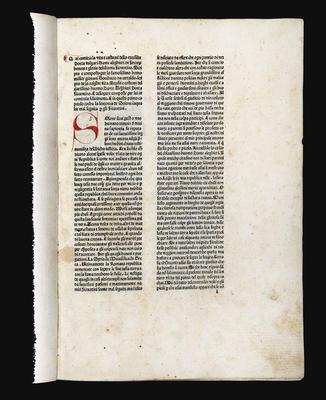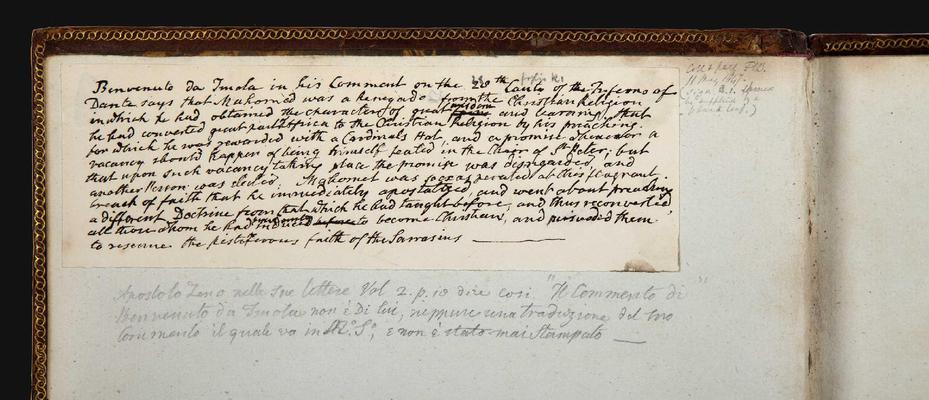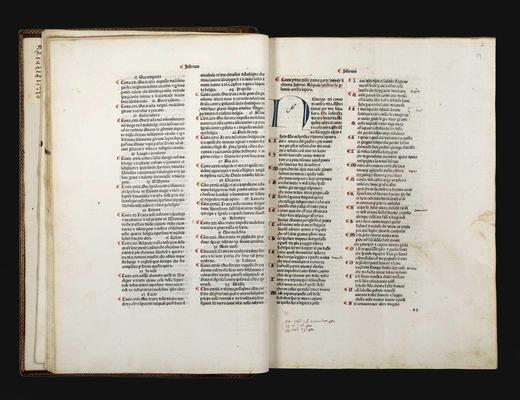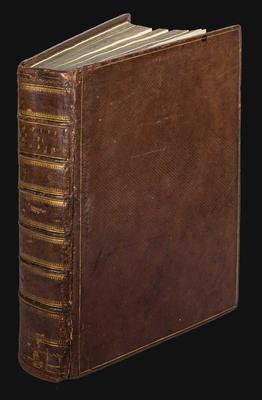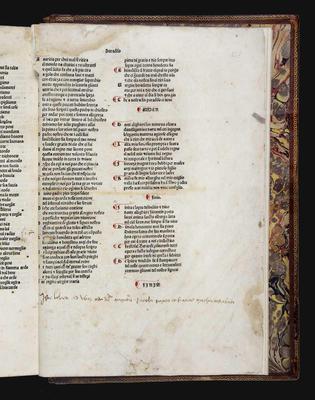Dante Alighieri
Qui comincia la vita e costumi dello excellente Poeta vulgari Dante alighieri di Firenze honore e gloria delidioma Fiorentino...
Venice, Vindelinus de Spira, 1477.Folio (327x230 mm). Collation: a8, e8, a-k10, l-m8, n-s10, t-u8, x-y10, aa-ff10, hh-ii8, kk-oo10, pp12. [373] of [376] leaves, without the blanks a1,2a1 and pp12. Complete, including the first two quires containing the Vita Dantis by Boccaccio, often lacking. Text in two columns, 46-49 lines. Type: 5:89G. In the commentary blank spaces of different shapes and sizes for woodcuts, never printed. Initials painted alternately in red and blue, capitals touched with red. Nineteenth-century English hazel diced calf, over pasteboards. Spine with six raised bands, compartments underlined by gilt fillets and narrow frieze; title in gilt lettering. Marbled pastedowns and flyleaves, inside dentelles. Edges green speckled. The lower cover slightly scuffed. A very fine, wide-margined copy. A few small wormholes on the first and final leaves, with the partial loss of a few letters. Old repairs to the margins of the last leaf, a short tear at the gutter. A few maniculae, marginal markings, and numerous glosses in a contemporary hand. Bibliographical notes in Italian and English on the recto of the rear flyleaf.
Provenance: ‘Iste liber ad usum magistri Jacobi pazzi et fratris mattei costaforti' (contemporary ownership inscription on fol. pp11r); Livio Ambrogio collection.
A beautiful copy of the first edition of the Commedia to contain a commentary and other earlier encomiastic and exegetical texts: a publishing initiative which testifies to the common practice in the fifteenth century of reading Dante with the assistance ofsummaries, biographies, and commentaries. The volume was prepared by the humanist Cristoforo Berardi from Pesaro, and it is one of the few books produced by the second Venetian press established by Vindelinus in 1476. In contrast with other fifteenth-century editions of the Commedia, and possibly as a consequence of the particular manuscript used as copy-text, in setting the volume Vindelinus employed not a roman type, but a gothic one. The vernacular commentary accompanying the poem is the Comento by Iacomo della Lana, one of the most authoritative Dante commentators of the late fourteenth century, though in this edition it is wrongly ascribed to Benvenuto da Imola. By way of introduction the Vindeliniana presents the first edition of the Trattatello in laude di Dante by Giovanni Boccaccio, the text of which was probably only added at the end of printing, since it is missing from many of the surviving copies. The other works included are the so-called Credo piccolo by Iacomo della Lana, the well-known capitoli on the first cantica composed in the fourteenth century by Jacopo Alighieri – one of Dante's sons – and Bosone da Gubbio, the Credo at the time ascribed to Dante, and the famous sonnet Dante Alighieri son, Minerva oscura, sometimes credited to Boccaccio himself. Except for the Credo, these works are all printed here for the first time.
The colophon is in the form of a sonnet composed by Cristoforo Berardi, who calls Dante “inclito et divo dante alleghieri Fiorentin poeta” (i.e. “illustrious and divine Dante Alighieri Florentine poet”). It has been suggested that the use of the epithet ‘divine' here led to the poem later – beginning with Ludovico Dolce's edition printed by Giolito in 1555 – being called the Divina Commedia, whereas in the fifteenth century and earlier it was simply known as the Commedia.


